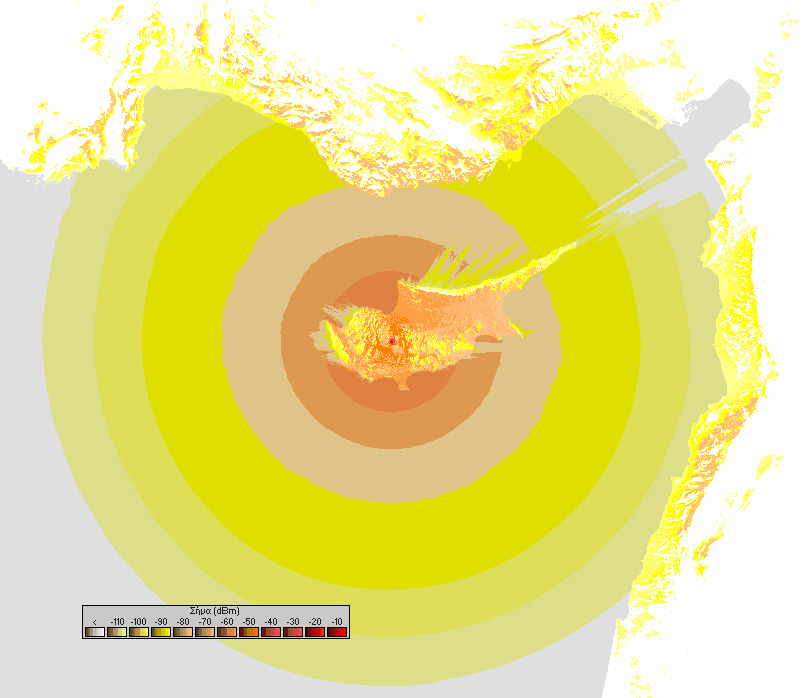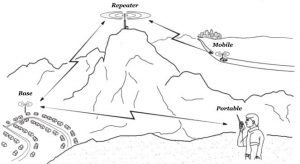- Current Amateur Service Repeater frequencies are set by the IARU Region 1 VHF/UHF/SHF working group and are allocated locally by the VHF Manager which takes into consideration various factors described in the VHF manager handbook, like for example other neighboring repeaters that may interfere.
Cyprus Repeaters Map
CARS Repeater Frequencies in use:
| Repeater Name & Location | Locator | Repeater Type | Repeater Status | Repeater Rx Freq. | PL Tone | Repeater Tx Freq. |
|---|---|---|---|---|---|---|
| RV48 –Troodos | KM64kw | Analogue | Active | 145.000 | 88.5 | 145.600 |
| RV50 – Vavatsinia | KM64ov | RX: Digital C4FM/Analog TX: Analog (fixed) | Inactive | 145.025 | 88.5 | 145.625 |
| RV52 – Larnaca City | KM64tw | Analogue | Active | 145.050 | 88.5 | 145.650 |
| RV54 – Troodos | KM64kw | Analogue/DMR/C4FM/D-STAR | Active | 145.075 | 88.5 | 145.675 |
| RV56 – Lemesos City | Analogue | Active | 145.100 | 88.5 | 145.700 | |
| RV58 – Nicosia City | KM65qe | Analogue | Active | 145.125 | 88.5 | 145.725 |
| RV58 – Statos (not CARS) | KM64hv | DMR | Active | 145.125 | 145.725 | |
| RV60 – Peyia Paphos | Analogue | Active | 145.150 | 88.5 | 145.750 | |
| RV60 – Fanos, Famagusta | Analogue | Planned | 145.150 | 88.5 | 145.750 | |
| RU672 – Troodos | KM64kw | DMR | Active | 430.800 | 438.400 | |
| RU656 – Nicosia (not CARS) | KM65qd | Analogue/DMR/C4FM/D-STAR | Active | 430.600 | 88.5 | 438.200 |
| RU680 – Larnaca (not CARS) | KM64tv | DMR | Active | 430.900 | 438.500 | |
| RU688 – Agia Napa (not CARS) | KM64xx | DMR | Active | 431.000 | 438.600 | |
| RU688 – Paphos (not CARS) | KM64ft | DMR | Active | 431.000 | 438.600 | |
| RU720 – Peyia (not CARS) | KM64eu | DMR | Active | 431.400 | 439.000 | |
| RU688 – Polis (not CARS) | KM64fa | DMR | Active | 431.000 | 438.600 | |
| RU688 – Episkopi (not CARS) | DMR | Active | 431.000 | 438.600 | ||
| RU696 – Fyti (not CARS) | KM64gw | DMR | Active | 431.100 | 438.700 | |
| RU752 – Larnaca City | KM64tw | Analogue | Active | 434.600 | 88.5 | 439.600 |
Note 1: The standard input offset for CARS 2m repeaters is -600KHz, and for 70cm repeaters -5MHz. Mic modulation narrow setting is advised in order to comply with the new IARU Channel distribution put in effect in 2014.
Note 2: To access the D-STAR Repeater use “5B4CY C”.
Note 3: To access the D-STAR Gateway use “5B4CY G”.
Note 4: TS1 on the DMR repeaters is for use on any international Talk Groups and as a secondary channel for TG280. TS2 on the DMR repeaters is for using TG280 and the local TG for the region the repeater is located at (eg. Paphos TG2806, Limassol TG2805, Larnaca TG2804, etc).
CARS Simplex Frequencies in use:
- V40 (old S20) – 145.500
- V42 (old S21) – 145.525
- V44 (old S22) – 145.550
- V46 (old S23) – 145.575
Repeater Coverage of RV48 and RV50 Repeaters

Repeater News
C4FM WIRES-X, YSF and D-Star XLX operational and linked to DMR BM
The Nicosia Club is pleased to announce that the link between WIRES-X room "Nicosia-Cyprus" DTMF ID: 41002 and Brandmeister DMR TG28097 has been re-established. Connected on the same Talkgroup is the YSF reflector "YSF Cyprus" (ID: 14353). This way C4FM(Yaesu System Fusion) users can talk through WIRES-X 41002 or YSF Cyprus to DMR users. Also the D-Star reflector XLX146 has been re-established and Module E is linked to DMR TG 28096 allowing D-Star users to talk to DMR users ...
DMR in Cyprus bridged with C4FM
CARS is happy to announce that the Wires-X room "Nicosia-Cyprus" with ID: 41002 has been bridged with the DMR talk group 28097. This means that C4FM users connected to the Wires-X Room 41002 will now be able to talk to DMR users connected to talkgroup 28097 ...

How to talk on a VHF/UHF repeater
We understand that getting on the air can be a bit intimidating. Don't worry; we've all been rookies at some point in our radio amateur lives. • Take the time to listen to the repeaters. • Speak like you were talking to someone face to face. Key the microphone, AND THEN start to talk. Don't start speaking as you key the mic. Repeaters have a short delay before transmitting. If you start speaking too soon, your first few words may not be heard. Make sure you have finished talking before you un-key the mic. Give your call sign clearly, and slowly. Also once in a conversation before you reply back leave at least 3 seconds space before keying again for anyone else who wishes to break into the conversation. • Avoid phonetics unless you are asked to do so. When using phonetics, use standard phonetics. "Alpha, Bravo, Charlie"... etc. • If you are listening and would like to have a conversation, just give your call sign. You can add "monitoring", or "listening” or "standing by" for any call. Using the term "CQ" on a repeater is generally discouraged. • When you wish to communicate on a frequency, listen for a ...
Major upgrade to the Cyprus VHF network
We are very pleased to inform you that the CARS VHF network has received a much needed major upgrade over the past few months. Lot's of CARS members have worked tirelessly for this upgrade, for who I am especially thankful to ...
Introduction to D-STAR
What is D-Star? The D-STAR system provides digitally modulated voice/data communication and high-speed data access over the air. This project has been developed in collaboration with JARL (Japan Amateur Radio League) and is supported by the Japanese Telecommunications Administration. D-STAR is an exciting new form of Amateur Radio that compliments other parts of the hobby including VHF, HF operation, Contesting and Satellite communications etc. Utilising digital communication and the Internet, D-STAR allows you to communicate worldwide with other operators who are connected to D-STAR repeaters. Reference: Icom America An Overview D-STAR, a standard published in 2001, is the result of years of research funded by the Japanese government and administered by the JARL to investigate digital technologies for amateur radio. D-STAR is an open protocol - published by JARL, it is available to be implemented by anyone. Whilst Icom is the only company to date that manufactures D-STAR compatible radios, any equipment or software that supports the D-STAR protocol will work with a D-STAR system. In a D-STAR system, the air link portion of the protocol applies to signals travelling directly between radios or between radios via a repeater. D-STAR radios can talk directly to each other without any ...
First Steps with a D-Star Radio
As you first un-box your new D-STAR radio, the first thing to do is to make sure that it works on FM. So program your favorite repeater and try it out for a little bit. Once you know your radio is working, then it is time to start thinking D-STAR ...
Operating D-STAR
To a great extent, operating using the D-STAR system is like operating using FM repeaters. Most of the same basic courtesies and procedures exist. But there are a few exceptions...Calling Stations: When calling stations, especially a CQ / General Call, you need to specify where you are calling from. Are you on the local repeater are on a remote repeater? Any station that wants to respond to your call needs to know how to program their radio.Example: Is there anyone listening on the KI4SBA repeater, this is WA4YIH on the WD4STR repeater module A.You can't hear remote activity - When you have your radio set to talk to someone other than your local module, you can't hear any of the remote stations. So when you start talking, please realize that there might be a QSO already occurring on the remote repeater. You can check www.dstarusers.org to see if it has registered any recent conversations.Station Identification - While the D-STAR protocol handles legal identification requirements for the US-FCC, some countries require voice identification. Just to make sure that everyone stays happy, operators continue to identify just as if they were using any other voice mode.Linking Repeaters - With the initial version ...
Accessing D-STAR
While the obvious way to access the D-STAR system is to get a D-STAR radio, there are numerous other ways.We can access D-STAR through the following methods: Commercially available radios from Icom Talk to the D-STAR network using a PC and the DVDongle Modify many radios to talk D-STAR using the Icom D-STAR modules Listen and decode D-STAR signals using a basic receiver Interface with the gateway software When you get a commercially available radio, you get the following features: Talking to other D-STAR users Talking to other D-STAR systems on any frequency they support (144, 440, 1200 MHz) Sending low speed data from computers by connecting to a D-STAR radio Sending high speed data from computers by connecting to an Icom ID-1 The following requires minor homebrew, some commercial does exist *: Decode D-STAR signals using basic receiver * while some commercial interfaces exist, many tend to connect to standard audioports, not the 9600 baud ports. May require different connectors The following requires significant homebrew Connect Icom D-STAR module to radio with controller The following is available to repeater owners as additions to the gateway: Customized IDs DVDongle Access Controls EchoTest DPRS/APRS linkage At this time, the following solutions ...
D-STAR Repeater relocation and activation from Troodos
It is with great pride and excitement that CARS announces the completion of another one of our major projects. After months of planning and hard work, the CARS D-STAR repeater has finally been relocated to it's final operating position, Mt. Troodos, thereby providing coverage to the whole of the Island. Having completed this admittedly complex task, a number of thank you notes are now due: Ham Association of Greece – for the donation of the D-STAR VHF Repeater, Controller and Gateway pc including the relevant software. 5B4AHS (Igor) – for the donation of a quad half-wave dipole array antenna. 5B4AHZ (Nestoras) – for the donation of a GSM remote controlled power supply controller. 5B4SN (Christis) – for hosting the D-STAR gateway. 5B4SD (George) – for the donation of a suitable cabinet to host the D-STAR Repeater system, as well as all other CARS equipment located at the specific location. Zittis Grocery in Agios Dometios – for the loan of the truck used in carrying oversized materials to Troodos. Mr. Nicolas Jacovides – for electrical engineering works and support. In addition to the above material donations, a great big thank you goes out to the following members who have ...
RV58 (R5) Repeater linked to the Panhellenic repeater system via Echolink
CARS is happy to announce the linking of the RV58 (R5) repeater via Echolink to the Panhellenic repeater network of the Ham Association of Greece. All members are asked to adhere to the repeater usage rules and regulations while using the above repeater as anything transmitted over this repeater is repeated instantly to the whole of Greece. Should anyone spot any problems arising from this link please contact the CARS Secretary, 5B4AHZ - Mr Nestoras Jacovides ...
